Poverty & Development Issues - 1 | Indian Society for UPSC CSE PDF Download
Introduction
Poverty is a multidimensional phenomenon in which a person or community lacks the financial resources and essentials for a minimum standard of living.
According to World Bank, Poverty is pronounced deprivation in well-being, and comprises many dimensions. It includes low incomes and the inability to acquire the basic goods and services necessary for survival with dignity. Poverty also encompasses low levels of health and education, poor access to clean water and sanitation, inadequate physical security, lack of voice, and insufficient capacity and opportunity to better one’s life.
Each nation may have its own threshold that determines how many of its people are living in poverty.
In India, 21.9% of the population lives below the national poverty line in 2011. In 2018, almost 8% of the world’s workers and their families lived on less than US$1.90 per person per day (international poverty line).
Types of Poverty
- Measures of absolute poverty are usually based upon the idea of subsistence. In other Words, people are in poverty if they do not have the resources to maintain human life.
- Supporters of the concept of relative poverty, however, tend to dismiss this view. They argue that a definition must relate to the standards of a particular society at a particular time
(i) Absolute poverty
It refers to a condition where a person does not have the minimum amount of income needed to meet the minimum requirements for one or more basic living needs over an extended period of time. It may be calculated in monetary terms, nutrition attainment or calories terms.
For example: Homeless people living on the streets, families that cannot afford to buy food to feed themselves and their children are also examples of absolute poverty.
(ii) Relative poverty
It occurs when people do not enjoy a certain minimum level of living standards as determined by government (and enjoyed by the bulk of population) that vary from country to country, which is said to be increasing and may possibly never be eradicated.
For example: For example, in the UK relative poverty is defined as income 50% less than average incomes or someone living in a rich society may have a steady income and all the necessities for living, but because they do not have as many luxuries as others living in the society, they are said to be in relative poverty.
Measurement of Poverty
- Pre-independence poverty estimates
- Post-independence poverty estimates
Broadly, the poverty of a given society is expressed in terms of malnutrition, low consumption expenditure, low income, chronic illness or poor health, illiteracy, unemployment, unsanitary housing conditions, poor resources, high disparity income distribution.
Pre-independence poverty estimates
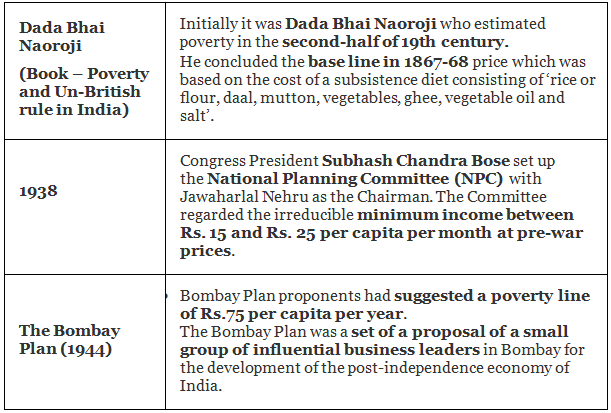
Post-independence poverty estimates
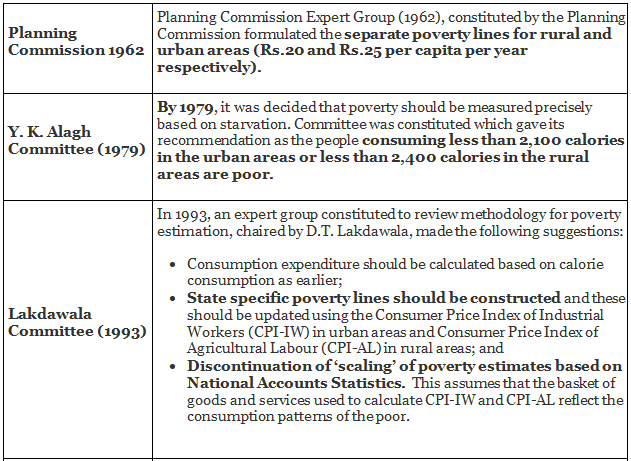
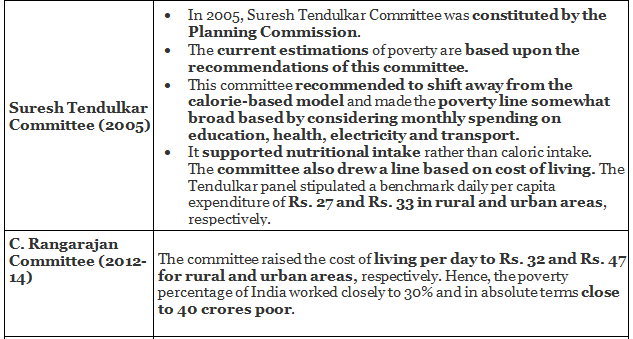
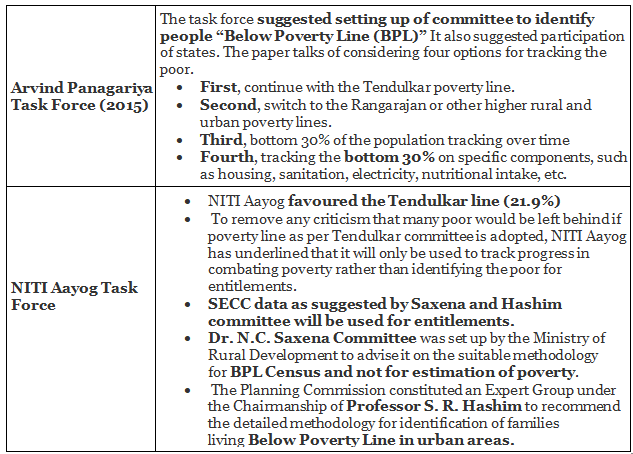
Challenges in Estimating Poverty
- Components of PLB - Determining components of Poverty Line Basket (PLB) is one of the challenges of poverty line estimation because of the price differentials (of constituents of basket) which vary from state to state and period to period.
- Variations across states - Some states such as Odisha and West Bengal supported the Tendulkar Poverty Line while others such as Delhi, Jharkhand, Mizoram etc. supported Rangarajan report.
- The current official measures of poverty are based on the Tendulkar poverty line, fixed at daily expenditure of ₹27.2 in rural areas and ₹33.3 in urban areas is criticised by many for being too low.
- Demographic and Economic Dynamics - Further, consumption patterns, nutritional needs and prices of components keep on changing as per dynamics of macro economy and demography.
- Lack of consensus among the states - over the acceptance of Tendulkar and Rangarajan committee report. Some states such as Odisha and West Bengal supported the Tendulkar Poverty Line while others such as Delhi, Jharkhand, Mizoram etc. supported Rangarajan report.
- Most of the governments have mothballed the reports of committees and panels - because this issue is not only politically sensitive but also has deeper fiscal ramifications.
- Problem of determining threshold - If the poverty threshold is high, it may leave out many needed people; while if it is low, then it would be bad for fiscal health of the government.
Way Forward
- Redefining Poverty lines - Poverty lines have to be recalibrated depending on changes in income, consumption patterns and prices.
- Viable Poverty line - It makes sense to set the poverty line at a level that allows households to get two square meals a day and other basic necessities of life.
- Hybrid of Absolute and Relative Measurement of Poverty - The hybrid approach which would measure poverty from the perspective of a common global standard of living and relative poverty within countries. The poverty line in case of hybrid model would be equivalent to the income required to achieve a certain welfare status, which includes basic nutrition and social inclusion.
- Political Economic Equilibrium - Indian political, policy and administrative systems have to adjust to the new realities of the transition to a middle- income country, in which poverty does not mean living at the edge of hunger but, rather, lack of income to take advantage of the opportunities thrown up by a growing economy. The focus of government spending should be on the provision of public goods rather than subsidies.

Causes of Poverty

1. Climatic factors
- The hot climate of India reduces the capacity of people especially the ruralites to work for which production severely suffers.
- Frequent flood, famine, earthquake and cyclone cause heavy damage to agriculture as a result, the price of food increases, and access becomes more and more limited, putting many at higher risk of hunger.
- Flooding can also contaminate water sources, increasing the transmission of water-borne diseases, such as Typhoid and Cholera.
- Moreover, absence of timely rain, excessive or deficient rain affect severely country’s agricultural production

2. Demographic factors
The following demographic factors are accountable for poverty in India:
3. Political Factors
Both rural and urban poverty remains ubiquitous even after more than seven decades of gaining independence from foreign rule. The reasons in this regard can be as follows:
- Communal tensions and strife between two regional parties disrupt the process of allowing concessions and solving poverty.
- In most cases, rural reforms are either stalled for indefinite period of time. Even if the measures are implemented, they are mostly half-measures and confined to short-term solutions that don’t do much good to India’s poverty reduction goals
- Vote bank politics is also held accountable for poverty in India where various political leaders find it convenient to exclude huge chunk of the population from the poverty census after getting elected. Minority ethnic communities, tribal groups and the Dalits are often not included in the list of beneficiaries
- Various development plans are being guided by political interests which is the major cause of concern for poverty in India. Hence, the planning has not been successful to tackle the problem of poverty and unemployment.
4. Population Growth
- On average, 17 million people are added every year to its population which raises the demand for consumption goods considerably.
- When the population increases, the scarce resource sharing is at stake which will create huge poverty gap.
5. Capital and Able Entrepreneurship Deficit
- Capital and able entrepreneurship have important role in accelerating the growth. But these are in short supply making it difficult to increase production significantly.
6. Housing and Homelessness
- The poor are, not surprisingly, more likely to be homeless than the not so poor but also more likely to live in dilapidated housing and unable to buy their own homes.
- Many poor families spend more than half their income on rent, and they tend to live in poor neighbour hoods that lack job opportunities, good schools and other features of modern life that wealthier people take for granted.
- The lack of adequate housing for the poor remains a major national problem. Even worse is the case for the complete homeless people.
Social Factor
1. Untouchability
- Various social issues like untouchability that are still prevalent in various parts of India are a major cause of hindrance in reducing poverty.
- They are not allowed to venture into the general employment opportunities and are forced to do in human jobs like manual scavenging.
2. Caste system
- The subordination of the low caste people by the high caste people caused the poverty of the former.
- Due to rigid caste system, the low caste people could not participate in the game of economic progress.
- For example: a lower caste person will not be allowed to become a businessman or a trader.
- Dalits are the least likely to start their own enterprises and most likely to work as labourers for others, with SCs having the lowest relative share in self-employed category and the highest share in casual labourer. The OBCs have a roughly proportionate share in each employment category.
- non-Muslim upper castes have a much higher share among white collar employees, while Dalits and Adivasis (SCs/STs) have a much greater share among unskilled workers in comparison to OBCs. Thus, even though SCs and OBCs might have a similar share among regular workers, the nature of jobs SCs (and STs) are engaged in is qualitatively different.
- This system makes the poor get poorer and the rich get richer. This unbalanced and unfair system is another leading cause of poverty.
- Laws of inheritance, caste system, traditions and customs are putting hindrances in the way of faster development and have aggravated the problem of poverty.
3. Lack of Education
- Education is an “agent of social change and egalitarianism”.
- Poverty is also said to be closely related to the levels of schooling, technical and vocational skills.
- Lack of education and illiteracy are the most important reasons for the prevalence of widespread poverty in India.
- The literacy rate of female Dalits in Bihar is around 38.5%, it is far behind India’s progress trend. It is still 30 years behind India’s national literacy rate.
4. Social exclusion
- Social exclusion is being unable to participate in society because of a lack of resources that are normally available to the general population.
- It can refer to both individuals, and communities in a broader framework, with linked problems such as low incomes, poor housing, high crime environments and family problems.
- Social Exclusion leads to Poverty in the following ways:
- Leads to the low representation of a section of society in government offices and this leads to fewer policies in favour of that particular section which can benefit them in a better standard of living.
- Exclusion imposes constraints under which human rights cannot be enjoyed in the same manner as by others in society. For example, basic rights like education and justice are denied, which further leads to poverty.
- The low participation of tribal in decision-making and their alienation from land and forests were central to the continued exclusion of Adivasis from progress and development.
5. Low Agricultural productivity
- Subdivided and fragmented holdings,
- Under-utilization of resources is important factor
- Disguised unemployment and underemployment in agriculture
- Lack of investible capital, and lack of credit availability.
- Use of traditional methods of cultivation
- Illiteracy etc. which are the very reason for poverty in this country.
6. Lack of employment opportunities
- Unemployment is the reflection of poverty.
- Because of lack of employment opportunities, people remain either unemployed or underemployed. Most of these unemployed and underemployed workers are the small and marginal farmers and the landless agricultural labourers.
- This inequality leads to unfair loss of opportunities among the weaker sections of the society thereby making them more vulnerable.
Inflation
- The persistent steep increase in the price of goods and services drastically affects the poor.
- For BPL people always find it difficult to cope up with these situations and their spending pattern gets affected.
- Inflation forces them to spend almost their entire income for the very basic necessities of survival like food, clothing and shelter, in that order.
- Sometimes, poor cannot have the basic required nutrition, hygienic living environment and cannot have basic minimum health care, and so become easy victims to malnutrition and disease. Thus, the inflation condemns the poor to a life time of bad health and worse living conditions.
- Finally, with passage of time, the inflation results in gradual declining of human dignity by rendering them homeless and sometimes even forcing them to beg.
Recent Context
- Recently, The Delhi High Court decriminalized beggary by striking down Delhi Prevention of Begging Rules, 1960, formulated under the Bombay Prevention of Begging Act, 1959 as unconstitutional.
- According to supreme court, Begging act violated Article 14 (equality before law) and Article 21 (right to life and personal liberty)of the Constitution.
Multidimensional Poverty
- The Global Multidimensional Poverty Index(MPI) was developed in 2010 by the Oxford Poverty & Human Development Initiative (OPHI) and the United Nations Development Programme and uses health, education and standard of living indicators to determine the degree of poverty experienced by a population.
- MPI is composed of ten indicators spread across:
Each education and health indicator have a 1/6 weight, each standard of living indicator a 1/18 weight.
Recent Trend
- Global Multidimensional Poverty Index – 2019 (MPI), has revealed that there are vast inequalities across countries, and among the poorer segments of societies.
- As per the index 1 – 3 billion people in the world are still multidimensionally poor.
Multidimensionally poor implies that poverty is defined not simply by income, but by a number of indicators, including poor health, poor quality of work and the threat of violence.
India’s ranking in the report
- Education: years of schooling and child enrollment.
- Health: child mortality and nutrition.
- Standard of living: Electricity, flooring, drinking water, sanitation, cooking fuel and assets.
- India lifted 271 million people out of poverty between 2006 and 2016, (reduced from 0.283 in 2005-06 to 0.123 in 2015-16) recording the fastest reductions in the multidimensional poverty index values during the period with strong improvements in areas such as assets, cooking fuel, sanitation and nutrition.
- Bangladesh, Cambodia, Democratic Republic of Congo, Ethiopia, Haiti, India, Nigeria, Pakistan, Peru and Vietnam(10 selected countries have a combined population of around 2 billion people) have shown significant progress towards achieving SDG-1 i.e. ending poverty in all its forms, everywhere.
- Among 10 selected countries India(and Cambodia) reduced their MPI values the fastest and they did not leave the poorest groups behind.
Effects of Poverty
1. Effects of poverty on health
- A universal and simple measure of poverty consists in looking at different populations’ health and life expectancy.
- They are always more likely to have many kinds of health problems, including infant mortality, earlier adulthood mortality and mental illness, and they are also more likely to receive inadequate medical care, discrimination and unfair treatments.
- Differential prices under National List of Essential Medicines (NLEM) and non NLEM category creates ambiguity and widens margin for private hospitals to exploit patients.
- SDG 3 – Ensure healthy lives and promote wellbeing for all at all ages.
Privatization of healthcare in India is a major cause of concern. It is riddled with various issues. According to 71st National Sample Survey (NSS) total private hospitalization share in rural and urban areas is 58% and 68% respectively in 2014.
According to the Health Profile of India report, 75 % of patients, who visit private hospitals, settle medical bills from their household income or life savings (out of pocket expenditure) while another 18 % borrow money from private lenders to pay medical bills causing high level of impoverishment.
2. Effects on society as a whole
- Poverty is a major cause of social tensions and threatens to divide a nation because of the issue of inequalities, in particular income inequality. This happens when wealth in a country is poorly distributed among its citizens
- The poor are more likely to be homeless and unable to buy their own homes. Many poor families spend more than half their income on rent, and they tend to live in poor neighbourhoods that lack job opportunities, good schools and other features of modern life that wealthier people take for granted.
- The lack of adequate housing for the poor remains a major national problem. Even worse is the case for the complete homeless people.
3. Effects of poverty on children
- Poor infrastructures, unemployment, lack of basic services and income reflect on their lack of education, malnutrition, violence at home and outside, child labor, diseases of all kinds, transmitted by the family or through the environment.
- These problems in turn weaken their ability to do well in school and stable employment as adults, helping to ensure that poverty will stick with the society across generations.
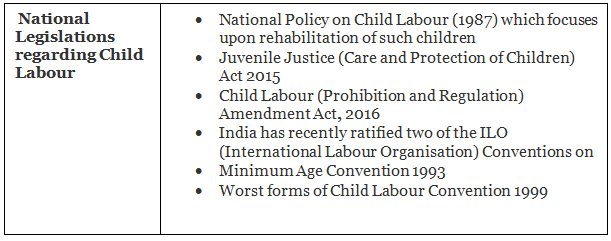
4. Effect of poverty on Education
- Education increases individual earnings
- Education increases earnings by roughly 10% per each additional year of schooling
- Education reduces economic inequalities
- If workers from poor and rich backgrounds received the same education, disparity between the two in working poverty could decrease by 39%.
- Education promotes economic growth
- No country in the world has achieved rapid and consistent economic growth without at least 40 percent of its adult population being literate.
- Poor children typically go to badly maintained schools with inadequate facilities where they receive poor coaching.
- They are less likely than wealthier children to graduate from high school or to go to college.
- Their lack of education in turn restricts them and makes their own children to suffer from poverty, once again helping to ensure a vicious cycle of sadly continuing poverty across generations
5. Effects of poverty on terrorism
- It’s important to note that most of the time terrorists do come from poorer countries with high unemployment, and that terrorist organizations often provide much higher salaries than any other job, if any other job is available at all.
- In fact, a lot of different factors interact with the decision to become a terrorist. Personal and cultural ideals, values, and principles are just as important as material and social gain (reputation & fame for fighting the imperialists) of entering terrorism.
6. Effect of poverty on Economy
- Among the effects of poverty, its impact on the economy of the country is a major issue of concern. Mainly, the number of people existing in poverty influences employment rates
- Without an education, people are unlikely to find a lucrative or rather a decent paying job.
- A high unemployment rate will definitely slow down a country from progressing in all aspects.
Feminization of poverty
- Poverty affects greater number of women than men. Feminization of poverty is the phenomenon in which total of poor women outnumbers the total population of poor men.
- Women are segregated, have very limited access to education (for political, religious or social reasons) and are sometimes forbidden to work or restricted to tedious ones.
- Being the cornerstone of the family, women can have a great impact not only on the household income, but also on the education of children (including sanitation), and avoiding early child deaths due to bad habits, sanitation or improper food or water.
- The feminization of poverty may be caused by changes in Family composition, Family organization, Inequality in the access to public services or in social protection.
The female face of poverty
- Unpaid work done by women across the globe amounts to a staggering $10 trillion a year, which is 43 times the annual turnover of the world’s biggest company Apple, according to an Oxfam study.
- Inequality has ‘female face’ in India, women’s unpaid work worth 3.1% of GDP.
- Women spend 312 minutes per day in urban areas and 291 minutes per day in rural areas on such unpaid care work, it added. In comparison, men spend only 29 minutes in urban and 32 minutes in rural areas on unpaid care work.
- Although India has many laws that deal with violence against women, but their implementation remains a challenge, including due to a deeply patriarchal society.
- Government Measures
- Distributive Strategies
- Specific Strategies
- Social Security
|
21 videos|125 docs
|
FAQs on Poverty & Development Issues - 1 - Indian Society for UPSC CSE
| 1. What are the main causes of poverty? |  |
| 2. How does poverty affect development? |  |
| 3. What are some strategies to alleviate poverty? |  |
| 4. How does poverty impact children? |  |
| 5. What is the role of international cooperation in addressing poverty and development issues? |  |
















